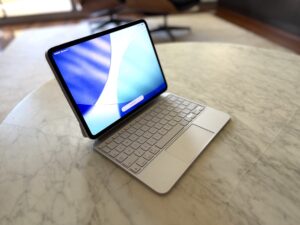
Apple’s iPad Pro continues to set the standard in the tablet market, and with the introduction of the M5 chip in the 2025 model, it takes performance to unprecedented heights. While the exterior remains unchanged from its predecessor, the M4-equipped 2024 model, the real advancements lie beneath the surface. The new iPad Pro retains its sleek design, available in 11-inch and 13-inch sizes, and features the same stunning Tandem OLED Ultra Retina XDR display.
Having extensively used both models, the key enhancements in the M5 version revolve around its power, connectivity, and subtle yet impactful quality-of-life improvements.
Pricing and Model Options
The iPad Pro M5 comes in several configurations, catering to different needs and budgets:
- 11-inch iPad Pro (Wi-Fi): $1,699
- 11-inch iPad Pro (Wi-Fi + Cellular): $2,049
- 13-inch iPad Pro (Wi-Fi): $2,199
- 13-inch iPad Pro (Wi-Fi + Cellular): $2,549
Under the Hood: M5 Power and Performance
The M5 chip represents the latest evolution in Apple’s silicon technology, debuting in both the iPad Pro and the 14-inch MacBook Pro. The base models, with 256GB and 512GB of storage, feature a 9-core CPU, while the 1TB and 2TB variants boast an additional performance core, totaling ten cores.
Built on a 3-nanometre process, the M5 chip is both powerful and efficient. According to Apple, its 10-core GPU includes neural accelerators capable of handling AI tasks up to 3.5 times faster than the M4. New shader cores and third-generation ray tracing are also 1.5 times faster than before.
Apple claims the M5’s Neural Engine has been upgraded to enhance Apple Intelligence features, allowing more tasks to run faster while consuming less power.
Memory bandwidth has increased to 153GB/sec, reducing latency and accelerating heavy workloads. Base models now come with 12GB of unified memory, up from 8GB on the M4, while the 1TB and 2TB models offer 16GB. Storage read and write speeds have doubled, significantly benefiting users working with large video files or datasets.
Benchmark Performance
In Geekbench 6 and Geekbench AI tests, the iPad Pro (M5) demonstrated a clear performance lead, particularly in graphics workloads. While CPU gains are modest, the overall combination makes the M5 the most capable tablet for creative apps, gaming, and professional workloads.
The M5’s GPU shows a major uplift in AI workloads, positioning it as a more future-ready device for next-generation AI applications.
Connectivity and Charging Innovations
Apple’s shift to in-house networking silicon marks another significant change in the M5 iPad Pro. The new N1 wireless chip supports Wi-Fi 7, Bluetooth 6, and Thread for smart-home networking.
Wi-Fi 7 offers higher speeds, better stability, and lower latency. Bluetooth 6 enhances energy efficiency and enables distance measurement between compatible devices, paving the way for more precise accessories and location tracking.
The new C1X modem boosts cellular connections with up to 50% faster 5G speeds and improved power efficiency. The Wi-Fi + Cellular models now support up to eight eSIMs, ideal for frequent travelers.
For wired connections, the iPad Pro retains Thunderbolt 3 and USB 4 support, offering data transfer speeds up to 40 Gbps. While Thunderbolt 5 would have been a welcome addition, the existing support for external displays up to 6K at 60Hz and 4K up to 120Hz with adaptive sync remains impressive.
Apple has introduced fast charging, allowing users to reach 50% battery in approximately 30 minutes with a 60W or higher USB-C power adapter.
Display, Cameras, and Accessories
The Tandem OLED Ultra Retina XDR display, unchanged from the M4 model, continues to be a standout feature. It offers 1600 nits of peak brightness and maintains 1000 nits full-screen brightness. With excellent color accuracy, P3 wide color support, a 120Hz ProMotion refresh rate, and perfect contrast thanks to OLED technology, it remains one of the best displays on any tablet.
The camera setup remains solid, with the 12MP Centre Stage and Face ID cameras positioned on the long edge for more natural video calls. Centre Stage effectively tracks subjects and adjusts framing quickly. The rear 12MP camera and LiDAR sensor are available for AR and 3D applications, though their use may be limited for most users.
All accessories from the previous generation are compatible with the M5 iPad Pro, including the Apple Pencil Pro, Magic Keyboard, and Smart Folio.
Target Audience and Purchase Considerations
For day-to-day use, the M5 iPad Pro feels similar to the M4 unless pushed hard with demanding applications. Current M4 owners may not find a compelling reason to upgrade unless they require the M5’s enhanced capabilities.
However, for new buyers or those seeking to future-proof their devices for AI tools and intensive workflows, the M5 model is unparalleled. It is particularly suited for professionals involved in 4K–8K video editing, 3D rendering, live production, and machine learning applications. Gamers will also appreciate the faster ray-tracing performance, which promises console-class visuals once developers optimize for it.
In summary, the 2025 iPad Pro with the M5 chip refines an already world-class tablet, offering faster AI performance, increased memory, improved wireless connectivity, and fast charging, all while maintaining its beautiful display and design. For those serious about creative work, AI workflows, or seeking the most capable tablet available, this is the device to buy. For others, the 2024 M4 iPad Pro continues to offer incredible value.






